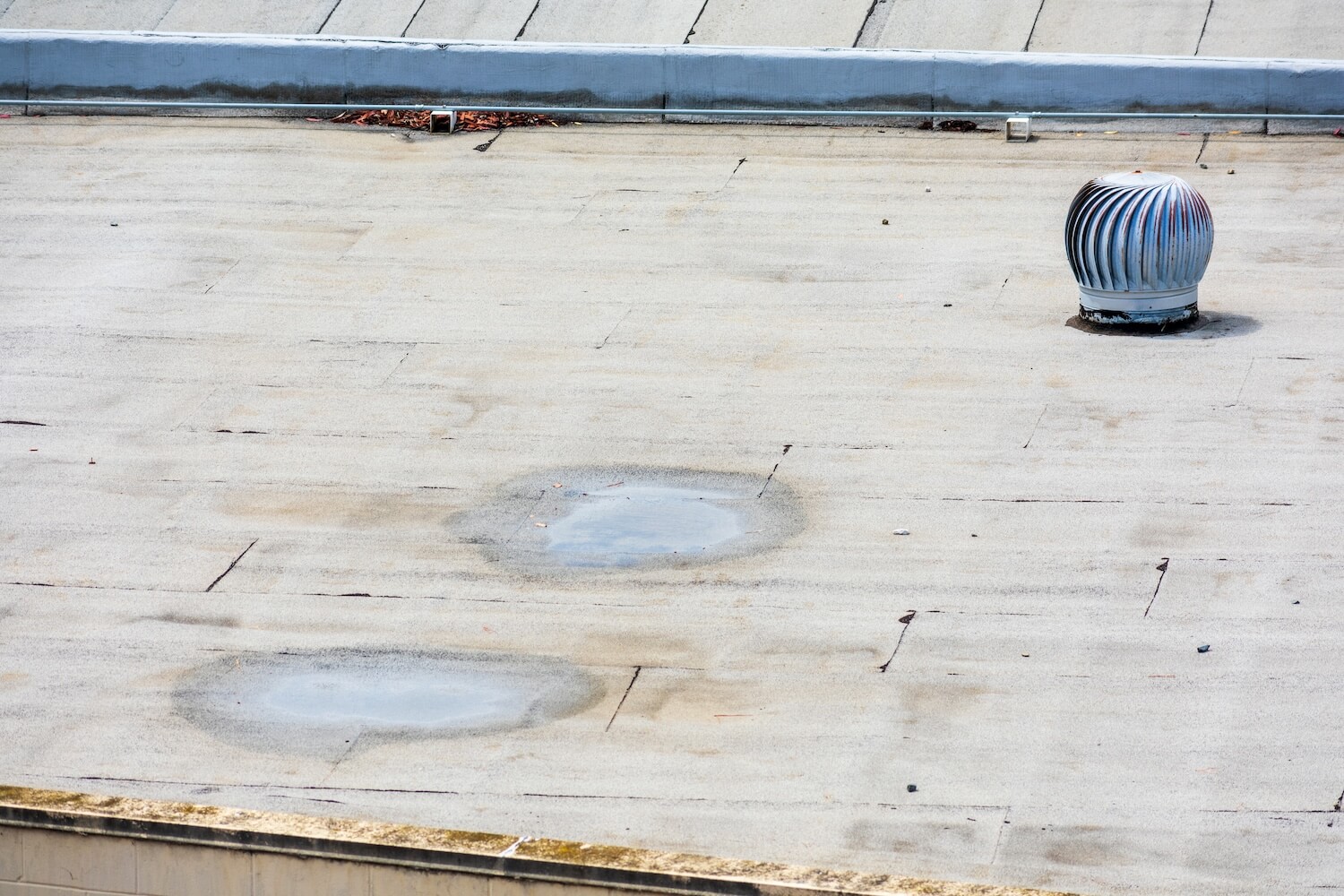Ponding water on commercial roofs is a prevalent issue that can lead to severe structural damage, mold growth, and costly repairs if not promptly addressed. For building owners and facility managers in Eugene, Oregon, understanding the causes, risks, and preventive measures of ponding water is essential to maintaining a durable and safe roof. Eugene’s climate—characterized by consistent rainfall, wet winters, and occasional freezing temperatures—presents unique challenges for commercial roof maintenance.
In this article, we’ll explore what ponding water is, why it’s a common problem for commercial roofs, the risks associated with it, and practical steps that you can take to prevent it and preserve the integrity of your roof.

What is Ponding Water?
Ponding water refers to the accumulation of standing water on a roof that does not drain off in a reasonable amount of time, typically within 48 hours. It is common on flat or low-slope roofs, which are often used in commercial buildings due to their cost-effectiveness and the ability to maximize space. In these designs, water relies heavily on gravity and the roof’s drainage system to flow off the roof. However, when the roof is not properly sloped, or drainage systems are clogged or compromised, water can collect and remain stagnant, resulting in ponding.
Although some amount of water accumulation may be expected after a rainstorm, prolonged ponding poses serious risks to the roof’s structure and functionality. It’s critical for property managers and building owners to understand how ponding water can affect their commercial roof and how to combat it.
Why Does Ponding Roof Water Occur?
There are several reasons why ponding water occurs on commercial roofs. These causes can range from poor roof design to maintenance neglect. Let’s explore the primary factors:
1. Improper Roof Slope
A flat roof without proper slope is one of the leading causes of ponding water. A well-designed flat roof should have a slight slope (typically between 1/8 to 1/4 inch per foot) to ensure that water flows toward the drains. If this slope is insufficient, water will collect in low-lying areas instead of being directed toward the drainage systems.
2. Clogged or Damaged Drains
Roof drains, gutters, and downspouts are integral components of a roof’s drainage system. They allow water to flow off the roof and prevent pooling. However, these systems can become clogged with leaves, debris, or even moss, preventing water from draining properly. Clogged drains are particularly problematic in Eugene’s wet climate, where leaves and organic debris accumulate more frequently, especially in the fall.
3. Damaged Roofing Materials
A damaged roof membrane, flashing, or seams can allow water to infiltrate the roofing system, causing degradation of materials over time. Membranes such as TPO (Thermoplastic Olefin), EPDM (Ethylene Propylene Diene Monomer), and PVC (Polyvinyl Chloride) are prone to punctures or tears that can compromise the roof’s ability to shed water. Once these materials are compromised, they can cause water to collect and lead to localized ponding.
4. Debris Accumulation
Debris, including branches, leaves, and dirt, can accumulate in certain areas of the roof, obstructing the natural flow of water. This often happens when roof inspections and cleaning are neglected. In Eugene, where heavy rainfall and windstorms are common, debris can easily gather on flat roofs, contributing to water pooling.
5. Poor Installation of Roof Components
Improper installation of roof drains, flashing, or even the roofing membrane can create areas of low points where water accumulates. Sometimes, these issues arise due to poor workmanship during the initial construction or renovation of the building. These design flaws can lead to drainage inefficiency and, consequently, ponding.
The Risks of Ponding Water on Commercial Roofs
While a small amount of standing water may seem harmless, ponding water can pose a serious threat to both the roof structure and the building itself. Here are the main risks:
1. Structural Damage
Ponding water places excessive weight on the roof, which can lead to structural issues over time. Roofs are designed to support certain amounts of weight, including snow and the roof’s own materials. However, water that sits on the roof for extended periods adds significant pressure that can cause the roof to sag, warp, or even collapse if the weight becomes too much. This is especially concerning in commercial buildings with large roof areas, as the collective weight of standing water can be enormous.
2. Roof Deterioration and Material Breakdown
When water remains stagnant on a roof, it accelerates the degradation of roofing materials. For example, flat roof membranes such as EPDM, TPO, and PVC can begin to break down due to prolonged exposure to water. The constant presence of water can cause these materials to lose their elasticity and flexibility, making them more prone to cracks and leaks. Asphalt-based roofing systems may also soften and degrade when exposed to water for extended periods.
Additionally, ponding water can erode the seams and flashing around vents, chimneys, or HVAC units, which are common weak points on commercial roofs.
3. Water Intrusion and Leaks
Water infiltration is one of the most direct consequences of ponding. When roofing materials are compromised by standing water, the risk of leaks increases dramatically. Water may seep through damaged areas, causing interior damage such as mold growth, corrosion of electrical systems, rusting of steel structures, and damage to insulation. In commercial buildings, this can lead to costly repairs, business disruptions, and even legal liabilities.
4. Increased Energy Costs
In commercial buildings, the roof plays a significant role in the building’s insulation and energy efficiency. Ponding water on the roof can lead to increased heat absorption, raising the temperature inside the building and forcing HVAC systems to work harder. This increased strain on HVAC systems can result in higher energy costs over time, adding unnecessary operational expenses.
5. Health and Safety Hazards
Ponding water can create a breeding ground for mold and bacteria. The prolonged presence of moisture on the roof allows these microorganisms to thrive, potentially leading to air quality issues inside the building. Additionally, standing water on the roof can pose a safety risk to anyone working on the roof for maintenance or inspection, increasing the chance of slipping or falling.
6. Ice Dams and Freezing in Winter
Eugene experiences freezing temperatures in winter, which can turn ponded water into ice. As the water freezes and thaws repeatedly, it can cause damage to the roof membrane, gutters, and even the underlying structure. Ice dams, which form when melting water refreezes at the edge of the roof, can prevent water from draining properly, exacerbating the ponding issue and leading to additional damage.
How to Prevent Ponding Water on Your Eugene Commercial Roof
Preventing ponding water is a multi-faceted effort that requires attention to roof design, drainage systems, material maintenance, and regular inspections. Here are some strategies to prevent ponding and extend the life of your commercial roof:
1. Ensure Proper Roof Slope
One of the first steps in preventing ponding water is to ensure that your roof is designed with the proper slope. For flat roofs, this typically means creating a slight slope (at least 1/8 inch per foot) to encourage water runoff. If your roof was installed without adequate slope or has settled over time, you may need to consider adding tapered insulation or other structural modifications to improve drainage.
2. Regularly Clean Gutters and Drains
Gutters and downspouts are the primary means of removing water from the roof. However, they can become clogged with debris, especially in Eugene’s wet climate, leading to water backup and pooling. It’s essential to perform routine inspections and cleaning to keep these systems functioning properly. Ideally, gutters should be cleaned twice a year and after significant storms or when large amounts of debris accumulate. This proactive approach ensures that water is channeled away from the roof efficiently.
3. Monitor and Repair Roofing Materials
Regular inspection of the roof’s membrane and other materials is critical to identifying signs of wear and tear. Inspect seams, flashing, and vents for damage, and check for any areas where water may be entering or where the roof’s surface may be deteriorating. Repair any damage promptly to prevent leaks and ensure that water continues to flow properly off the roof. Professional roof inspections can help detect issues that might not be visible to the untrained eye.
4. Install Additional Drainage Systems
If your roof struggles with water drainage due to its design, consider installing additional drains or scuppers. These features can help divert water away from low-lying areas and into proper drainage channels. A roofing professional can assess whether your building requires additional drainage systems based on the current roof design.
5. Apply Reflective Roof Coatings
Reflective roof coatings not only protect your roof from UV rays but can also aid in water runoff by preventing water from accumulating in certain areas. Some coatings are designed to create a more even surface and reduce the likelihood of water pooling. This approach is particularly beneficial in regions like Eugene, where the weather can vary from heavy rain to intense sunlight.
6. Create a Roof Maintenance Schedule
One of the best ways to avoid ponding water is to implement a comprehensive roof maintenance schedule. This schedule should include regular roof inspections, cleaning of gutters and drains, and early identification of any problem areas. Consider partnering with a professional roofing company that offers regular maintenance services to keep your roof in optimal condition.
7. Invest in a Professional Roof Maintenance Plan
For commercial properties, working with a professional roofing contractor who offers comprehensive roof maintenance is invaluable. A professional roofing service will have the expertise to properly inspect, repair, and maintain your roof, ensuring that ponding water is prevented. Regular maintenance plans often include semi-annual inspections, cleaning, minor repairs, and recommendations for upgrades or improvements.
8. Monitor and Address Seasonal Changes
Eugene’s weather varies throughout the year, with heavy rainfall in the winter and warmer, drier conditions in the summer. Seasonal changes can affect the roof’s drainage capacity. In preparation for winter, it’s especially important to ensure that the roof’s drainage systems are clear and functioning properly to prevent ponding from becoming an issue. Checking for ice dams during cold weather is also critical to preventing freeze-related damage.
Ponding Water Conclusion
Ponding water on commercial roofs is a serious problem that can cause extensive damage if not properly managed. Building owners in Eugene, OR, must be proactive in ensuring that their roofs are designed, maintained, and inspected to prevent ponding. By following the preventive measures outlined above—such as maintaining proper slope, cleaning gutters and drains, monitoring roofing materials, and investing in professional maintenance services—you can avoid the risks associated with ponding water. With regular care and attention, your roof can remain durable, functional, and free from water-related damage for years to come.










